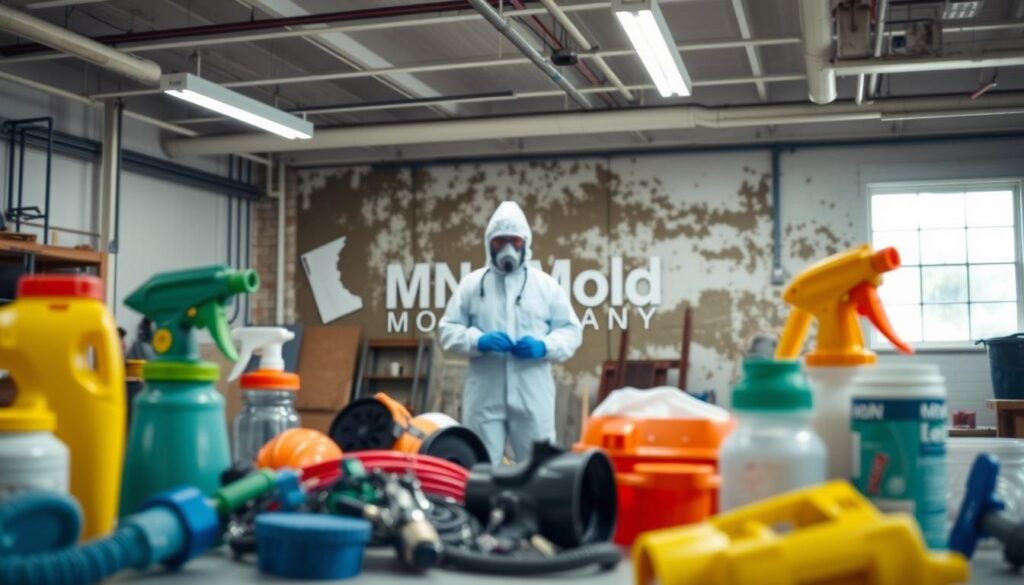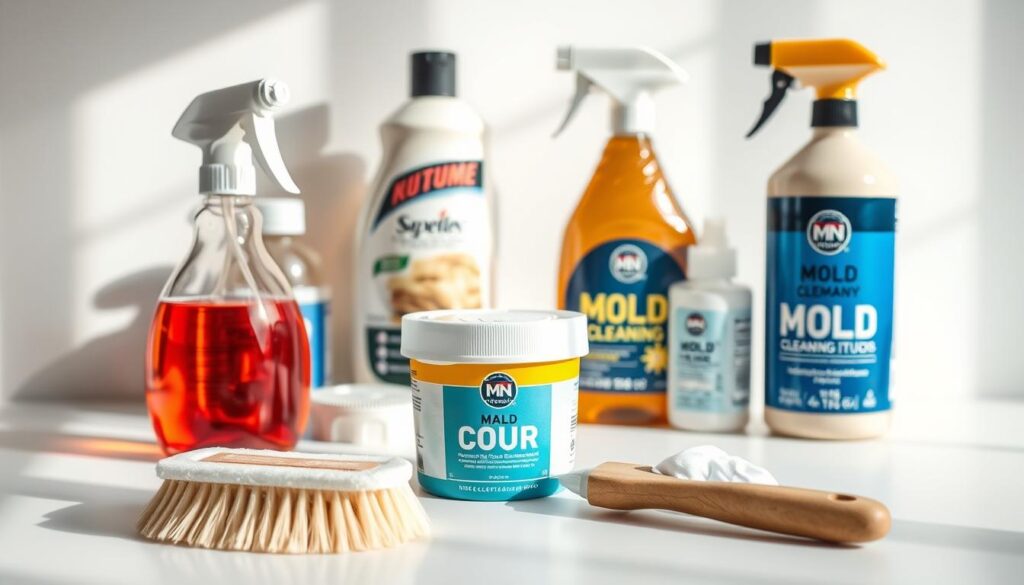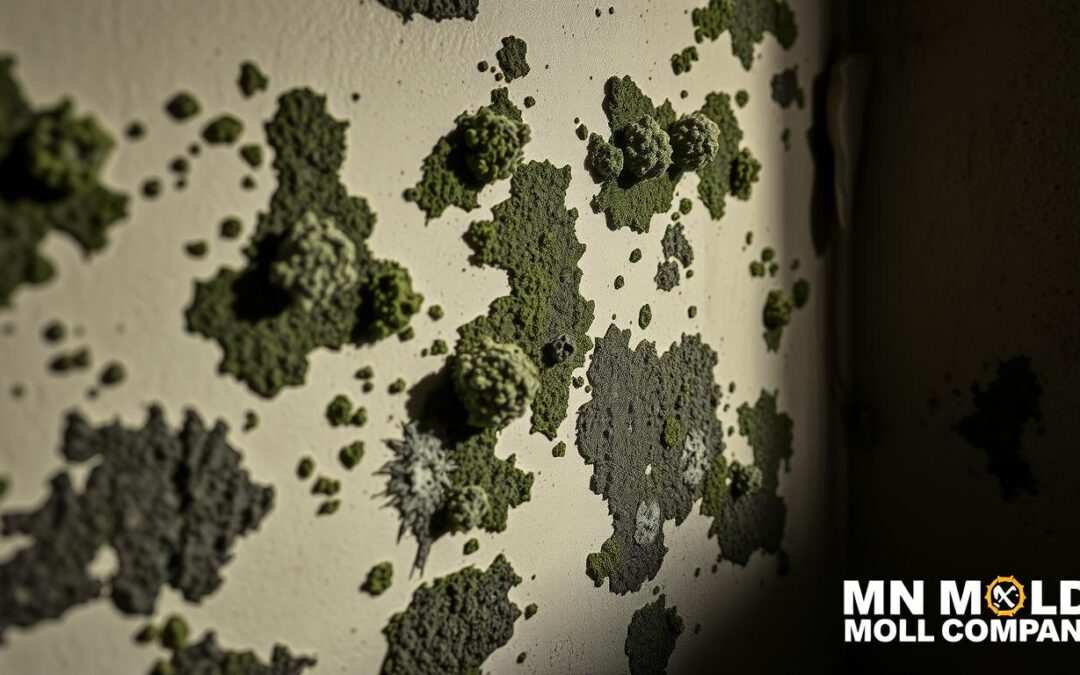Have you spotted mysterious black, gray, or green spots on your walls? Mold growth can be a sign of underlying moisture issues in your home. It’s not just an eyesore; it can also pose health risks and damage your property if left untreated. The good news is that addressing mold doesn’t have to be overwhelming.
Our certified mold technicians are here to help you tackle the problem effectively. We offer free mold inspections and convenient online booking for mold assessments. If you have immediate concerns, feel free to call us at 612-477-0804 for expert guidance.
Mold thrives in moist environments, and your walls can become a breeding ground if not properly ventilated. In this guide, we’ll walk you through simple, actionable steps to clean your walls and prevent future mold growth. Whether you prefer homemade solutions or commercial products, we’ve got you covered.
Key Takeaways
- Identify mold types and their causes on your walls.
- Learn effective cleaning solutions using bleach, vinegar, or commercial products.
- Understand the importance of ventilation and moisture control.
- Discover when to seek professional help for large mold areas.
- Prevent future mold growth with simple maintenance tips.
Introduction & Understanding Mold Growth
Mold and mildew are both types of fungi that thrive in damp environments. Mold is a deeper-rooted fungus that can appear in various colors, including black, green, or red. It often has a fuzzy texture and a strong, musty odor. Mildew, on the other hand, is a surface fungus that typically appears as a thin, white or gray growth. Unlike mold, mildew can usually be wiped away easily.
What Are Mold and Mildew?
Mold and mildew are both fungi that thrive in moist environments. They can grow on various surfaces, including walls, ceilings, and floors. Mold is more invasive and can penetrate deeper into materials, while mildew remains on the surface. Understanding the difference between the two is crucial for effective cleaning and prevention.
Common Causes on Interior Walls
Moisture is the primary culprit behind mold and mildew growth on interior walls. Condensation from windows, pipes, or appliances can create the perfect environment for spores to settle and grow. Lack of ventilation, especially in areas like bathrooms and kitchens, exacerbates the problem. Additionally, water leaks or flooding can lead to rapid mold growth if not addressed promptly.
Testing for mildew can be done using a simple bleach test. Apply a small amount of bleach to the affected area. If the discoloration fades, it’s likely mildew. If it remains, it could be dirt or another substance. This test can help homeowners identify and address issues early.
Addressing the root cause is essential to prevent reoccurrence. Fixing leaks, improving ventilation, and reducing humidity can significantly reduce the risk of mold and mildew growth. Regular inspections and professional cleaning when necessary are beneficial for maintaining a healthy and safe living environment.
Recognizing the Value of Free Mold Inspections
Spotting mold on your walls can be unsettling, but it’s a clear sign that action is needed. Mold growth often hides in areas you can’t see, like behind walls or under flooring, and can lead to serious damage if left unchecked. This is where professional inspections become invaluable.
A free mold inspection offers a detailed assessment of your home’s condition. Certified technicians use specialized tools to detect hidden mold and identify moisture sources. This ensures that any cleaning project is both effective and safe, preventing future issues.
Benefits of Scheduling a Free Inspection
- Expert assessment to identify hidden mold growth
- Accurate identification of moisture sources
- Customized cleaning and prevention recommendations
- Avoid costly damage with early intervention
Don’t wait until the problem escalates. Call 612-477-0804 for immediate assistance. Our certified technicians are ready to help you tackle mold issues promptly and effectively.
| Benefits | Details |
|---|---|
| Expert Assessment | Identify hidden mold and moisture sources |
| Custom Solutions | Personalized cleaning and prevention plans |
| Cost Savings | Avoid expensive repairs with early action |
How to Remove Mold from Walls
Removing mold from walls can be a straightforward process if you follow the right steps. Whether you prefer homemade solutions or commercial products, the key is to act quickly to prevent further growth and potential health risks.
Step-by-Step Cleaning Process
Start by preparing the area. Wear gloves, safety goggles, and a mask to protect yourself from spores. Open windows for ventilation. Mix a solution of one part bleach to four parts water or use white vinegar for a natural alternative.
Choosing Your Cleaning Solution
For a homemade approach, apply the solution to the affected area using a sponge. Let it sit for 10-15 minutes before scrubbing gently. Avoid soaking the wall to prevent moisture buildup. Rinse thoroughly and dry with a fan or dehumidifier to ensure the area is completely dry.
Commercial products offer convenience and strong cleaning power. Follow the manufacturer’s instructions carefully. Always test a small area first to ensure no damage occurs.
Remember, safety is crucial. If the mold covers a large area, consider consulting a professional. By following these steps, you can effectively remove mold and keep your walls clean and safe.
Prioritizing Safety When Removing Mold
When tackling mold removal, safety should always come first. Mold spores can pose serious health risks, making proper precautions essential. Whether you’re dealing with a small patch or a larger issue, protecting yourself is key to a successful and safe cleaning process.
Essential Protective Gear
To safeguard against mold exposure, wear waterproof gloves, a mask, and protective eyewear. An N-95 respirator is highly recommended to filter out spores. These items create a barrier between you and harmful particles, reducing the risk of inhalation and skin contact.
Ensuring Adequate Ventilation

Proper ventilation is crucial. Open windows to let fresh air circulate and use fans to prevent spores from spreading. This helps maintain a safe environment and reduces the concentration of mold particles in the air.
| Equipment | Purpose | Benefits |
|---|---|---|
| Gloves | Prevent skin contact with mold | Protects against irritation and exposure |
| Mask | Filters airborne spores | Reduces inhalation risks |
| Eyewear | Protects eyes from spores | Prevents irritation and infection |
Remember, safety measures are not just precautions—they’re necessities. By taking these steps, you ensure a safer and more effective cleaning process. Don’t let mold exposure compromise your health; stay protected and breathe easy.
Why Certified Mold Technicians Matter
When dealing with mold growth in your home, the expertise of certified mold technicians can make a significant difference. These professionals are trained to handle not just the visible mold but also the underlying issues that cause it, such as condensation and moisture buildup in bathrooms and kitchens.
Advantages of Hiring Certified Experts
Certified mold technicians undergo rigorous training and stay updated on the latest techniques and products. They can identify moisture sources effectively and use advanced tools for accurate mold detection, ensuring a thorough cleaning process.
| Advantages | Details | Benefits |
|---|---|---|
| Expert Assessment | Identify hidden mold and moisture sources | Faster, more reliable mold detection |
| Proven Methods | Use of latest techniques and products | Effective and safe mold removal |
| Root Cause Identification | Addressing underlying moisture issues | Long-term prevention of mold growth |
“Certified mold technicians bring a level of professionalism and expertise that ensures the job is done right the first time.” — International Association of Certified Indoor Air Consultants
How Certification Enhances Service Quality
Certification ensures that technicians follow strict protocols, protecting both health and property. They use advanced equipment like 3D cameras for faster and more precise remediation. Proper ventilation and timely action are crucial, and certified experts excel in these areas, safeguarding your home’s air quality and structural integrity.
Exploring Effective Mold Cleaning Products
When it comes to tackling mold, choosing the right cleaning solution is essential. Two popular options are bleach and vinegar, each with its own set of advantages and disadvantages.
Comparing Bleach and Vinegar
Bleach is a strong disinfectant, making it highly effective against mold. However, it can cause color damage on certain surfaces. A common solution is mixing one part bleach with four parts water. On the other hand, vinegar is a natural alternative that’s gentler on surfaces but may require longer application times.

When to Use Commercial Products
For tougher mold issues, commercial cleaning solutions might be necessary. These products often have stronger formulations but should be used with caution, following the manufacturer’s instructions carefully.
Always test any cleaning solution on a small area first to ensure there’s no damage. Safety is key, so wear gloves, a mask, and protective eyewear when cleaning.
Maintaining a Mold-Free Home Environment
Keeping your home free from mold requires consistent effort and attention to detail. By focusing on prevention, you can create a safer and healthier living space for everyone.
Preventative Strategies for Long-Term Protection
Proper ventilation is key to preventing mold growth. Use exhaust fans in bathrooms and kitchens, especially after showering or cooking, to remove moisture. Opening windows for fresh air and using dehumidifiers in damp areas like basements can also help maintain a dry environment.
Regular inspections are crucial. Check areas prone to condensation, such as windowsills and bathroom corners, for early signs of mold. Fixing leaks promptly and ensuring good airflow can prevent mold from taking hold. Don’t forget to clean and dry surfaces thoroughly after any water incident to stop mold in its tracks.
For wood and painted surfaces, regular maintenance is essential. Look for stains or discoloration, which could indicate moisture issues. Addressing these early can prevent mold growth and protect your home from damage.
By incorporating these simple strategies into your routine, you can keep your home mold-free and maintain a healthy indoor environment. Remember, prevention is always better than removal!
Conclusion
Taking charge of mold growth in your home is a crucial step toward maintaining a healthy and safe living environment. By following the steps outlined in this guide, you can effectively address mold issues and prevent future growth. Remember, whether you choose a homemade solution like vinegar or a commercial product, safety should always be your top priority. Use gloves, a mask, and ensure good ventilation to protect yourself from mold spores.
For larger areas or persistent mold, don’t hesitate to seek professional help. Our certified technicians offer free mold inspections and personalized solutions to tackle the root cause of the problem. Call us at 612-477-0804 to schedule your assessment and take the first step toward a mold-free home.
Regular maintenance is key to preventing mold. Keep your home well-ventilated, fix leaks promptly, and monitor moisture levels. By staying proactive, you can protect your walls, ceilings, and surfaces from mold damage and ensure a healthier space for everyone.
FAQ
Why does mold grow on walls and ceilings?
Mold thrives in damp environments. It often appears due to condensation, high humidity, or water damage. If your home lacks proper ventilation, especially in areas like bathrooms or kitchens, it creates an ideal breeding ground for mold spores.
What’s the best solution to clean mold from surfaces?
For minor mold growth, a mixture of vinegar and water is effective. For more severe cases, bleach solutions or specialized mold removal products are recommended. Always wear a mask and gloves for protection.
Can I use a fan to dry moldy areas?
Yes, but with caution. Fans can help speed up the drying process after cleaning. However, avoid using them before removing mold, as this could spread spores into the air, worsening the problem.
How do I prevent mold from coming back?
Regularly check for moisture issues, improve ventilation by using exhaust fans, and ensure your home is well-maintained. Fixing water leaks promptly and reducing humidity levels are key to a mold-free environment.
Is vinegar as effective as bleach for removing mold?
Vinegar is a safer, non-toxic option that can kill mold on surfaces. Bleach is stronger but may not penetrate deeply into porous materials. The choice depends on the severity of the mold growth and the type of material affected.
What protective gear should I wear while cleaning mold?
Always wear a mask to avoid inhaling spores, gloves to protect your hands, and protective eyewear. For larger areas, consider wearing a long-sleeve shirt and pants to prevent skin exposure.
Can mold damage wood surfaces permanently?
If left untreated, mold can rot wood and cause irreversible damage. Addressing the issue early and ensuring the wood is thoroughly dried can help prevent permanent harm. For severe cases, consult a professional to assess the damage.
How can I remove black mold from my bathroom?
Start by isolating the area to prevent spore spread. Use a scrub brush and a cleaning solution like bleach or vinegar. Scrub the affected area thoroughly, then rinse and dry it completely. Always wear protective gear during the process.
Will cleaning mold once keep it from coming back?
No. While cleaning removes the visible mold, it doesn’t address the root cause. To keep your home mold-free, fix any water damage, improve ventilation, and maintain a dry environment. Regular inspections are also essential.
When should I call a professional to handle mold removal?
If the affected area is large (more than 10 square feet) or if the mold has penetrated deeply into materials, it’s best to hire a certified mold technician. They have the tools and expertise to ensure the job is done safely and effectively.
Source Links
- Kill the Mold and Get Rid of the Stains on Your Walls – https://www.thespruce.com/how-to-clean-mold-off-walls-5220421
- Tips and Tricks From the Pros – https://www.servicemasterrestore.com/servicemaster-disaster-associates-stoneham/why-us/blog/2022/june/tips-to-remove-mold-from-the-walls/
- How to Remove Mold from Walls – https://www.truevalue.com/diy-projects/maintenance-and-repair/cleaning-and-organizing/remove-mold-from-walls/
- Lesson 1 – Introduction to Mold Growth – Mold Removal Bay Area – https://www.moldremedies.com/lesson-1-introduction-to-mold-growth/
- Understanding How Mold Grows and How to Prevent Mold Growth – https://www.moldsci.com/blog/posts/how-mold-grows-and-why-it-can-become-a-problem
- Cleaning and Removing Mold in Your Home – https://publications.extension.uconn.edu/publication/cleaning-mold/
- How to Get a Free Mold Inspection with Keystone’s Expertise. – https://www.keystonestaterestoration.com/post/how-to-get-a-free-mold-inspection
- Residential Mold Testing: What Every Homeowner Should Know | Indoor Doctor Types of Mold Testing, How to Hire for Mold Testing – https://www.indoordoctor.com/blog/residential-mold-testing-what-every-homeowner-should-know/
- How to Get Rid of Mold – https://www.homedepot.com/c/ah/how-to-get-rid-of-mold/9ba683603be9fa5395fab907c52351c
- How to Get Rid of Mould and Mildew on Walls – Step by Step Guide | Cleanipedia – https://www.cleanipedia.com/gb/floor-and-surface-cleaning/how-to-remove-mould-and-mildew-from-walls.html
- The Right Way to Get Rid of Mold in Your Home, According to Experts – https://www.marthastewart.com/273648/mold-tips
- How to Remove Mold From Inside Walls – https://www.thespruce.com/how-to-remove-mold-from-inside-walls-5211668
- How to remove mold from walls – https://www.1800gotjunk.com/us_en/blog/decluttering/remove-mold-from-walls
- Prioritizing Safety in Mold Cleanup: A Guide for Orlando Residents – https://www.floodprosusa.com/blog/p.241111003/prioritizing-safety-in-mold-cleanup-a-guide-for-orlando-residents/
- Why Certified Technicians Are Essential for Residential Restoration – https://www.goblusky.com/importance-of-certified-technicians/
- Why Mold Inspections and Testing Matter: Expertise You Can Trust – 20/20 Home Inspection of NJ – https://homeinspectorinnj.com/why-mold-inspections-and-testing-matter-expertise-you-can-trust/
- WHY USE A PROFESSIONAL MOLD REMEDIATOR – https://www.drytech24.com/2021/09/27/why-use-a-professional-mold-remediator/
- How to Clean Mold Off Walls – The Ultimate Guide – https://www.cleanerguys.com/how-to-clean-mold-off-walls/
- How to Remove Mold from Inside Walls and Ceilings – Trusscore – https://trusscore.com/blog/how-to-remove-mold-from-inside-walls-and-ceilings.html
- How to Get Rid of Mold on Bathroom Walls – https://www.familyhandyman.com/article/how-to-get-rid-of-mold-on-walls-in-the-bathroom/?srsltid=AfmBOor_N43isK5I_mRiWSf_ccRDQLJAQBhoixa2j2aguijW5ItZFzXZ
- Dealing with and preventing mold in your home – https://extension.umn.edu/moisture-and-mold-indoors/dealing-and-preventing-mold-your-home
- Expert Tips on How to Remove Mold from Walls – https://prepsmartpainting.com/blog/how-to-remove-mold-from-walls/
- Maintaining a Mold Free Home – Mold Remediation Water Restoration OTS Dyatona Beach – https://otsmold.com/maintaining-a-mold-free-home/
- How To Remove Mold On Drywall – https://www.thisoldhouse.com/walls/22215480/remove-mold-on-drywall
- How to remove mold from walls: 8 simple solutions – https://www.windowo.com/blog/how-to-remove-mold-from-walls
- How To Remove Mold From Walls – https://pnwrestorationservices.com/how-to-remove-mold-from-walls/

